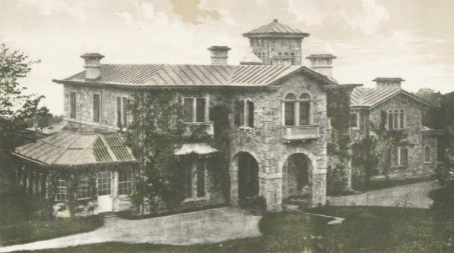Cunningham Castle & East Garden: Estates with deep artistic ties
 |
The 18-room Cunningham Castle, pictured ca. 1865, stood on North Broadway south of East Sunnyside Lane between the George Denison Morgan and Edmund Coffin estates. The mansion burned in 1878. (New York Public Library Digital Collections) |
James C. Cunningham (1801-70) was born in Port Glasgow, Scotland, became a mechanical engineer and made his fortune in the steamboat industry and real estate.
By 1860, Cunningham's real estate holdings alone were valued at about $500,000 -- $14.42 million today -- and that in an era with minimal property taxation and no federal income tax.
“Cunningham Castle,” his stone villa above North Broadway south of Sunnyside Lane, was built on an eight-acre property that included a greenhouse, presumably built by Irvington's Hudson River Valley greenhouse king Frederick A. Lord of Lord & Burnham fame.
Cunningham Castle was the house in which Cunningham lived and in fact it was also home to his daughter Mary and her husband Heber Reginald Bishop who inherited it after Cunningham’s death.
The house burned in 1878 and Bishop replaced it with a later mansion he named “Craig Hall.”
James Cunningham, a prodigious collector of art, owned a second Irvington estate of about 40 acres which began on the south side of Sunnyside Lane and ran directly behind estates on North Broadway owned by the Parish, Kittle, Fogg and Coffin families as well as his own Cunningham Castle and ending at the George Denison Morgan estate property line.
The purpose of the second estate, called “East Garden,” was to house Cunningham’s art collection. Much of that art was eventually donated to the Metropolitan Museum of Art, on whose board sat fellow art collector and aficionado son-in-law Heber Bishop.
Cunningham Castle was the smaller of the two mansions Cunningham owned in Irvington.
Cunningham’s son Francis lived at the second estate after Cunningham’s death in 1870. James Cunningham had intended to live in the larger house in retirement, but died before he effected that move. That house burned in 1901. Its replacement, called later known from 1909 at the latest as Aldwill, home to businessman Frederic Clark Sayles and his wife Mary Lamper Kingman Sayles and their eight children. After F.C. Sayles' sudden death at age 61 in 1929, the mansion was sometimes referred to as Sayles Chateau. It is now known as the “Old House," and stands at 50 East Sunnyside Lane opposite Tarrytown House, the former Duke Biddle estate Linden Court, 49 East Sunnyside Lane.
Since 1973, the so-called “Old House” on the East Garden estate has been preserved ad is part of the Hyo Jeong East Garden Museum, affiliated with the Unification Church.
The art of Heber and Cunningham that wound up at the Metropolitan Museum included the Bishop Jade Collection. The 1902 gift from Heber included works from China, Japan, Mexico, Central America, the northwest coast of America, Swiss lake dwellings, France, Italy, New Zealand and elsewhere. It also featured a rare crystal of jadeite and a single mass of nephrite from the former Jordansmühl, Silesia.
Heber’s children went on to live glamorous international lives. The family of his daughter, Edith Bishop Taylor, owned many residences including the Villa Taylor in French colonial Marrakesh, Morocco where British Prime Minister Winston Churchill and U.S. President Franklin Delano Roosevelt on Jan. 23, 1943, during their Casablanca Conference took a few days off and "played hookey" during World War II. The Taylors would cruise to Morocco aboard their 310-foot steam yacht "Iolanda."
 |
The original James C. Cunningham estates off North Broadway (vertical road in pink at left of map) included the Francis Cunningham estate “East Garden” and the Heber R. Bishop estate “Craig Hall.” James Cunningham’s home on the site of the later Craig Hall was called “Cunningham Castle” and it burned in 1878, eight years after Cunningham’s death. He had shared the home with his daughter, Mary, and her husband, Heber Bishop, who inherited the eight-acre estate, rebuilt the main house and renamed it. James Cunningham never lived in “East Garden,” a 40-acre estate he left to his son Francis. (Frederick W. Beers, 1891. David Rumsey Map Collection) * Click here for links to dozens of other Gilded Age stories by this author |












Comments
Post a Comment
If you would like to weigh-in, feel free ...